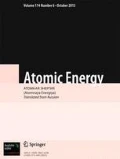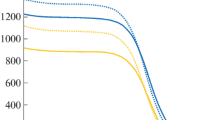The transient processes induced in a water-moderated and -cooled reactor by prolonged (several seconds) insertion of absorbing rods into the reactor are analyzed using experimental and computational data. The change in the neutron flux density in core regions, forming the detector signal, during the motion of the rods, and the subsequent change in the distribution of delayed-neutron sources are examined. The spatial effect of the reactivity is determined from the coefficient of nonuniformity of the neutron flux density. The conditions under which regression analysis can be used to determine the efficiency of the rods are discussed.
Similar content being viewed by others
References
Yu. A. Kazanskii, I. P. Matvienko, P. L. Tyutyunnikov, and L. D. Shokodko, “On taking account of the reactivity effects in measurements of the reactivity by the method of the inverse solution of the kinetic equations,” At. Énerg., 51, No. 6, 387–389 (1981).
A. S. Kaminskii and I. D. Krylov, Characteristics and Methods of Taking Account of the Spatial Kinetics in Reactivity Measurements, Preprint IAE-3884/4 (1984).
Yu. A. Kazanskii and E. S. Matusevich, Experimental Methods of Reactor Physics, Energoatomizdat, Moscow (1984).
Y. Chao, D. Chapman, D. Hill, and L. Grobmyer, “Dynamic rod worth measurement,” Nucl. Technol., 132, 403–412 (2000).
S. V. Tereshenok and V. P. Povarov, “Effect of the position of the ionization chambers relative to individual control rods in VVER-1000 on the indications of reactivity measurement devices,” Teploenergetika, No. 5, 22–25 (2003).
S. V. Tsyganov and L. K. Shishkov, “Measurement of the effectiveness of VVER control rods,” At. Énerg., 96, No. 3, 183–188 (2004).
V. S. Bobrov, G. V. Lebedev, and Yu. A. Nechaev, “Measurements of the effectiveness of control rods by the modernized inverse kinetics method,” Vopr. At. Nauki Tekhn. Ser. Fiz. Yad. Reakt., No. 3, 48–56 (2010).
D. L. Hetrick, Dynamics of Nuclear Reactors [Russian translation], Atomizdat, Moscow (1975).
V. A. Kuznetsov (ed.), Ship Nuclear Power Plants, Atomizdat, Moscow (1976).
I. Ya. Emelyanov, V. I. Mikhan, V. I. Solonin, et al., Nuclear Reactor Design, Energoatomizdat, Moscow (1982).
SAPFIR_VVR95&RC with the BNAB-78/S-95 Constants Library (neutron-physical calculation of propulsion reactors in the burnup process), Certificate No. 87, Dec. 18, 1997, Moscow (1997).
Author information
Authors and Affiliations
Additional information
Translated from Atomnaya Énergiya, Vol. 114, No. 1, pp. 8–12, January, 2013.
Rights and permissions
About this article
Cite this article
Vinogorov, N.A. Spatial Effect as a Consequence of a Mismatch between the Detector Signal and the Averaged Neutron Flux Density. At Energy 114, 8–13 (2013). https://doi.org/10.1007/s10512-013-9662-6
Received:
Published:
Issue Date:
DOI: https://doi.org/10.1007/s10512-013-9662-6




